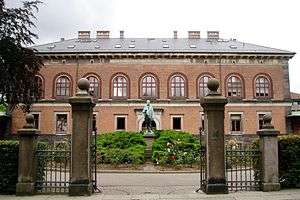Carlsberg Laboratory
The Carlsberg Laboratory in Copenhagen, Denmark, was founded in 1875 by J. C. Jacobsen, the founder of the Carlsberg brewery, with the purpose of advancing biochemical knowledge, especially relating to brewing. It featured a Department of Chemistry and a Department of Physiology. In 1972, the laboratory was renamed the Carlsberg Research Center and was transferred to the brewery.

Overview
The Carlsberg Laboratory was known for isolating Saccharomyces carlsbergensis, the species of yeast responsible for lager fermentation, as well as introducing the concept of pH in acid-base chemistry. The Danish chemist Søren Peder Lauritz Sørensen introduced the concept of pH, a scale for measuring acidity and basicity of substances. While working at the Carlsberg Laboratory, he studied the effect of ion concentration on proteins, and understood the concentration of hydrogen ions was particularly important. To express the hydronium ion (H3O+) concentration in a solution, he devised a logarithmic scale known as the pH scale.[1]
Directors
| Name | Period |
|---|---|
| Johan Kjeldahl | 1876–1900 |
| S. P. L. Sørensen | 1901–1938 |
| Kaj Ulrik Linderstrøm-Lang | 1938–1959 |
| Martin Ottesen | 1959–1987 |
| Klaus Bock | 1988–2006 |
| Jens Ø. Duus | 2006–2011 |
| Ole Hindsgaul | 2011–2014 |
| Birger Lindberg Møller | 2014–present |
See also
Footnotes
- "Properties of Acids and Bases (Theory) : Class 10 : Chemistry : Amrita Online Lab". Retrieved 14 October 2015.
References
- ^ Schellman JA, Schellman CG (May 1997). "Kaj Ulrik Linderstrøm-Lang (1896-1959)". Protein Sci. 6 (5): 1092–100. doi:10.1002/pro.5560060516. PMC 2143695. PMID 9144781.
Further reading
- Richards FM (1992). "Linderstrøm-Lang and the Carlsberg Laboratory: The view of a postdoctoral fellow in 1954". Protein Sci. 1 (12): 1721–30. doi:10.1002/pro.5560011221. PMC 2142135. PMID 1304902.
- Scheraga HA (1992). "Contribution of physical chemistry to an understanding of protein structure and function". Protein Sci. 1 (5): 691–3. doi:10.1002/pro.5560010515. PMC 2142232. PMID 1304368.
- Holter H, Møller KM, ed. (1976). The Carlsberg Laboratory 1876/1976. Copenhagen: Rhodos International Science and Art Publ.